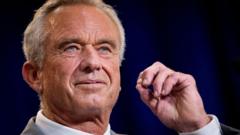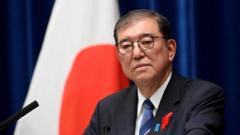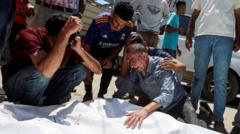In a landmark move, the World Health Organization (WHO) has finalized a legally binding treaty aimed at improving global preparedness for future pandemics, establishing a framework for swift cooperation among member states.
WHO Secures Historic Pandemic Treaty to Strengthen Global Response

WHO Secures Historic Pandemic Treaty to Strengthen Global Response
New legally binding agreement aims to improve cooperation among nations during future health crises.
As part of a three-year negotiation process, countries have promised to share data more rapidly regarding emerging diseases, facilitating the quick development of treatments and vaccines. This treaty is set against the backdrop of the inadequacies faced during the COVID-19 pandemic, which saw disarray and fierce competition for resources among nations.
Key to the agreement is a new international oversight mechanism for global supply chains of masks, medical gowns, and other personal protective equipment (PPE). WHO director-general Dr. Tedros Adhanom Ghebreyesus hailed this pact as a significant step forward, saying it exemplifies how nations can unite to confront common threats in an increasingly divided world.
The treaty, described as historic, will be formally adopted at the upcoming World Health Assembly next month. It marks only the second such agreement in the WHO’s 75-year history, following a tobacco control treaty established in 2003. However, the U.S., having announced its withdrawal from the WHO under the Trump administration, will not be bound by the treaty when it officially leaves in 2026.
Under the new terms, countries will be mandated to ensure that pandemic-related therapeutics are accessible worldwide, with manufacturers required to allocate 10% of their production of vaccines, drugs, and diagnostics to the WHO and supply another 10% at affordable prices. Furthermore, the agreement includes a provision for transferring health technologies to developing nations, conditional on mutual agreement.
Despite the progress, tensions remain, as developing countries express frustration over past vaccine distribution injustices, while nations with significant pharmaceutical sectors fear that mandatory technology transfers might deter innovation and research.
At its core, the treaty introduces the Pathogen Access and Benefit-Sharing System (PABS), which promises to streamline data exchange, enabling pharmaceutical manufacturers to initiate development of new medications quickly in response to any future health crises.
Key to the agreement is a new international oversight mechanism for global supply chains of masks, medical gowns, and other personal protective equipment (PPE). WHO director-general Dr. Tedros Adhanom Ghebreyesus hailed this pact as a significant step forward, saying it exemplifies how nations can unite to confront common threats in an increasingly divided world.
The treaty, described as historic, will be formally adopted at the upcoming World Health Assembly next month. It marks only the second such agreement in the WHO’s 75-year history, following a tobacco control treaty established in 2003. However, the U.S., having announced its withdrawal from the WHO under the Trump administration, will not be bound by the treaty when it officially leaves in 2026.
Under the new terms, countries will be mandated to ensure that pandemic-related therapeutics are accessible worldwide, with manufacturers required to allocate 10% of their production of vaccines, drugs, and diagnostics to the WHO and supply another 10% at affordable prices. Furthermore, the agreement includes a provision for transferring health technologies to developing nations, conditional on mutual agreement.
Despite the progress, tensions remain, as developing countries express frustration over past vaccine distribution injustices, while nations with significant pharmaceutical sectors fear that mandatory technology transfers might deter innovation and research.
At its core, the treaty introduces the Pathogen Access and Benefit-Sharing System (PABS), which promises to streamline data exchange, enabling pharmaceutical manufacturers to initiate development of new medications quickly in response to any future health crises.






















